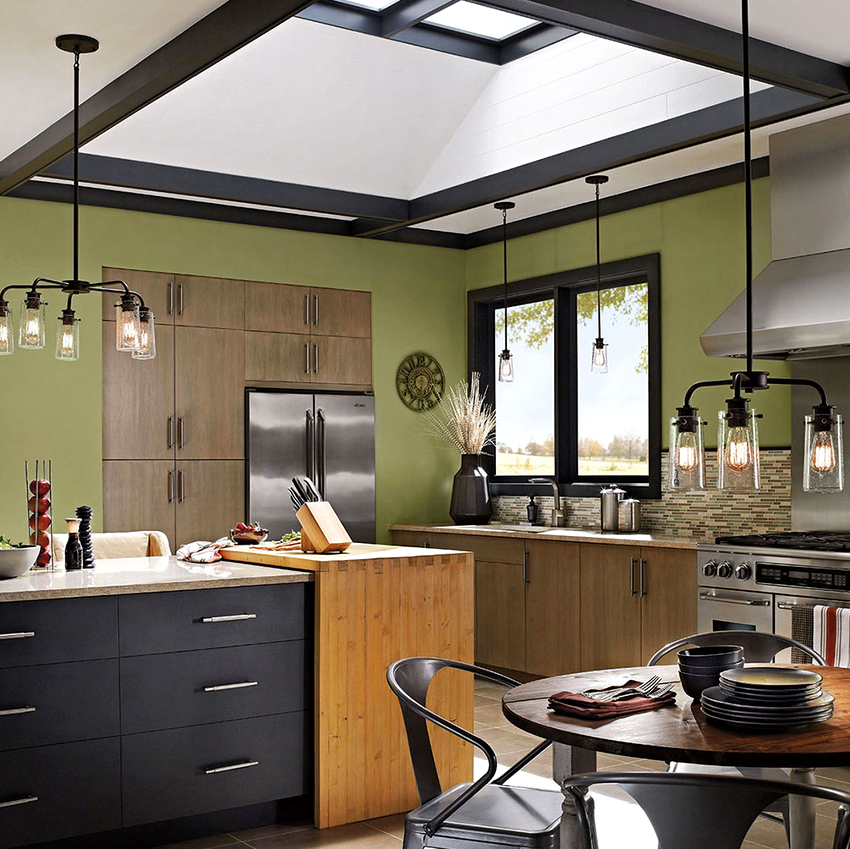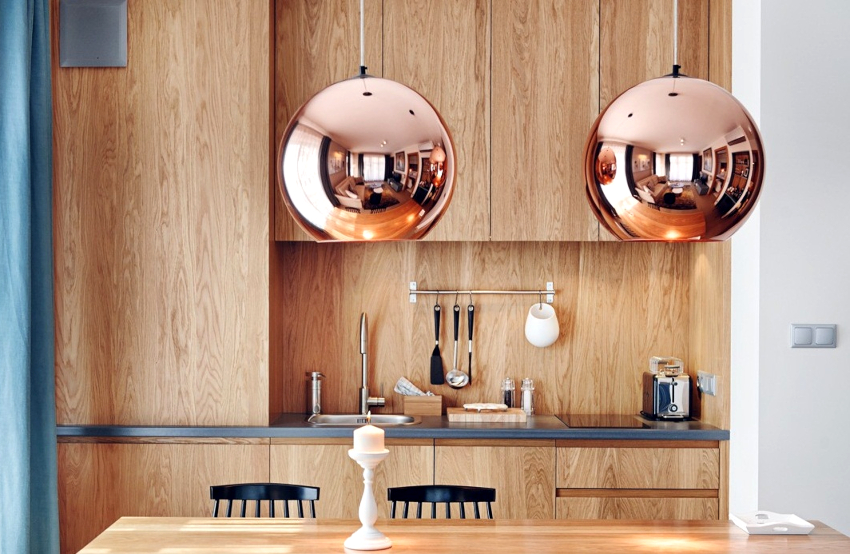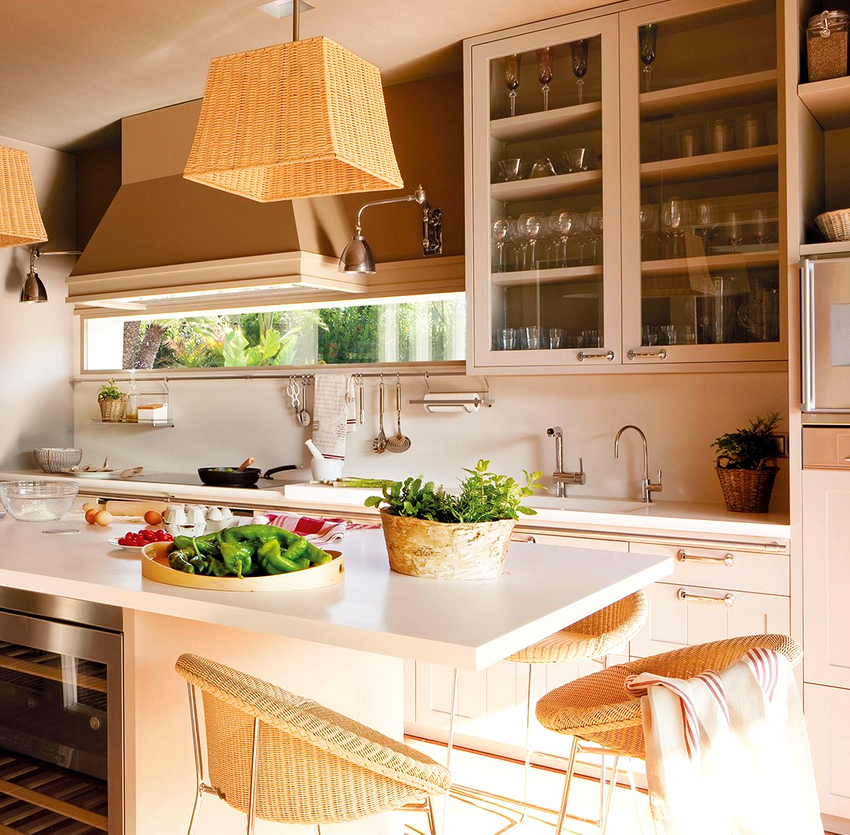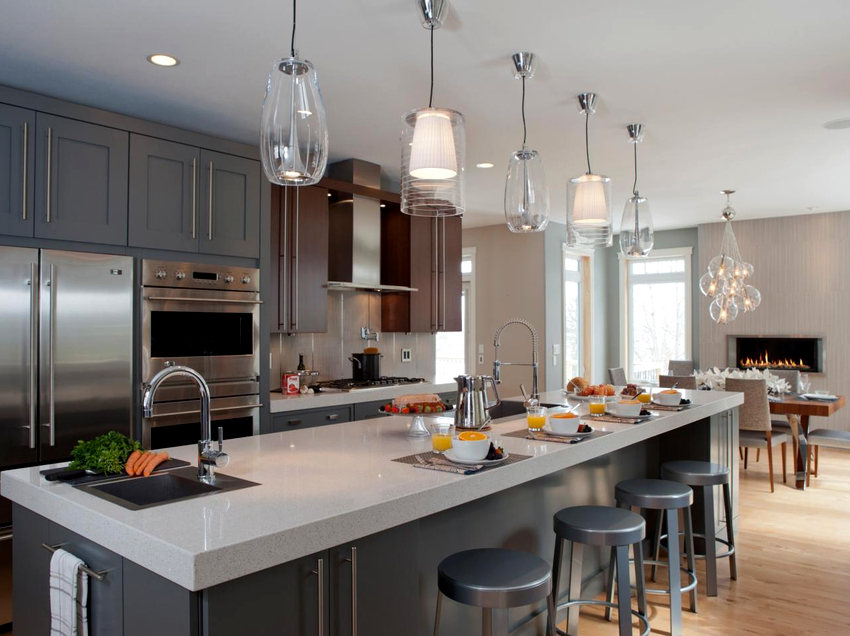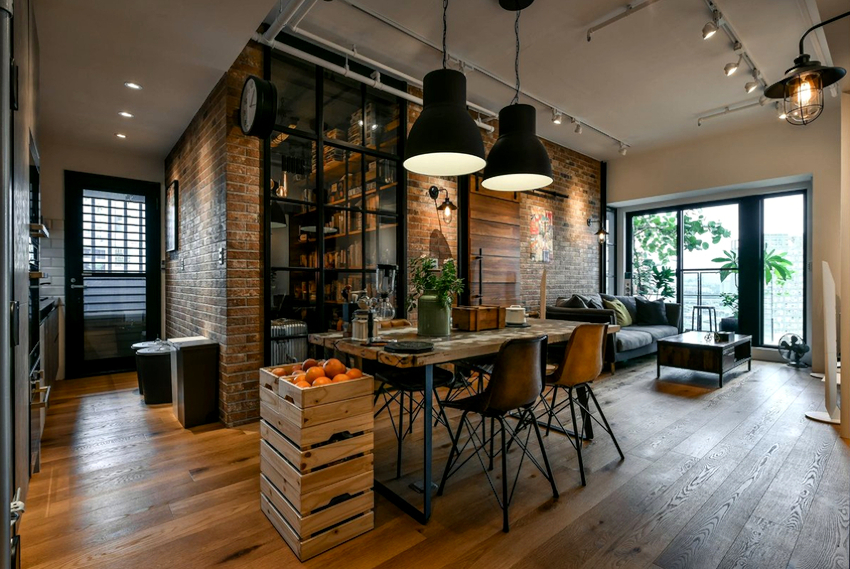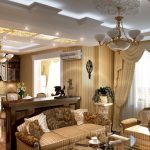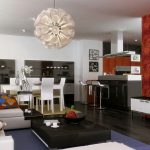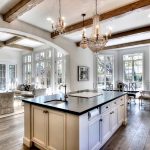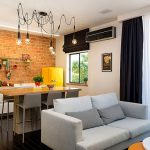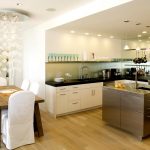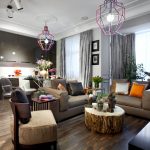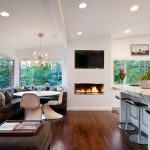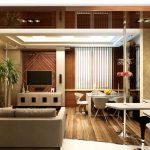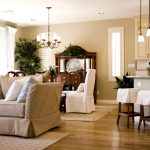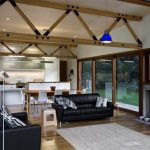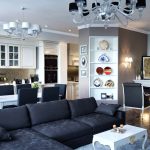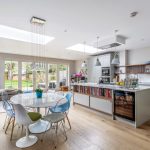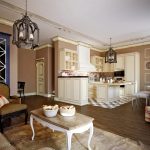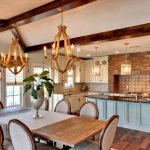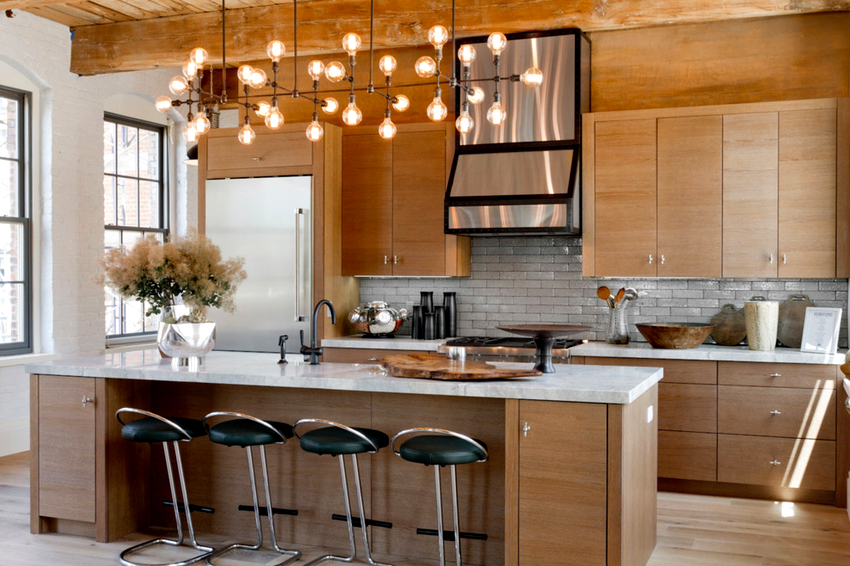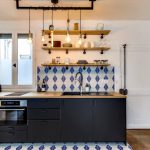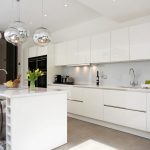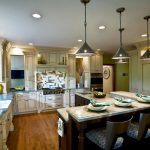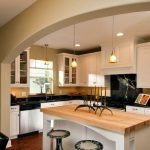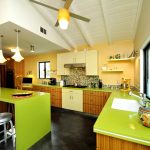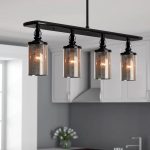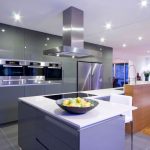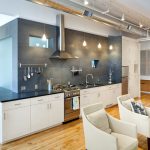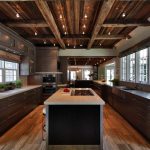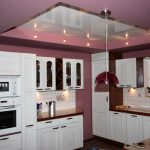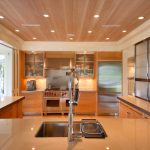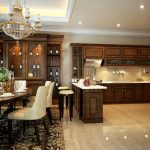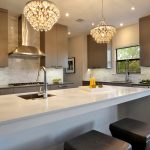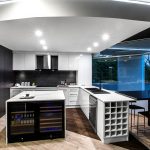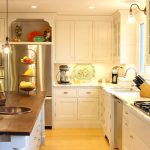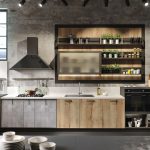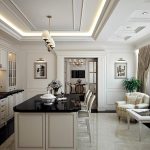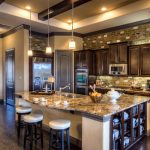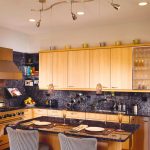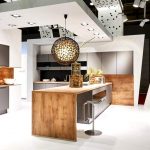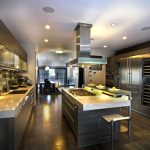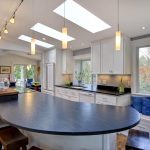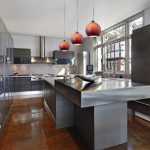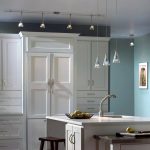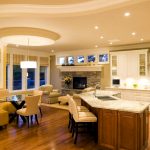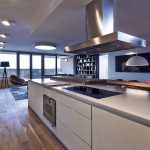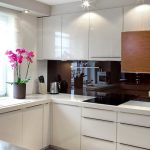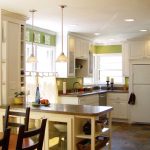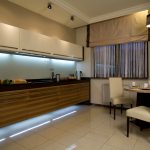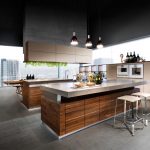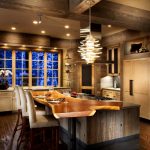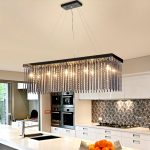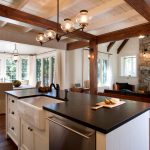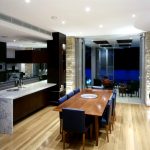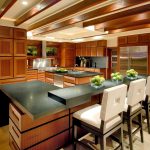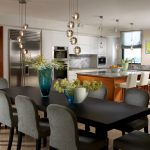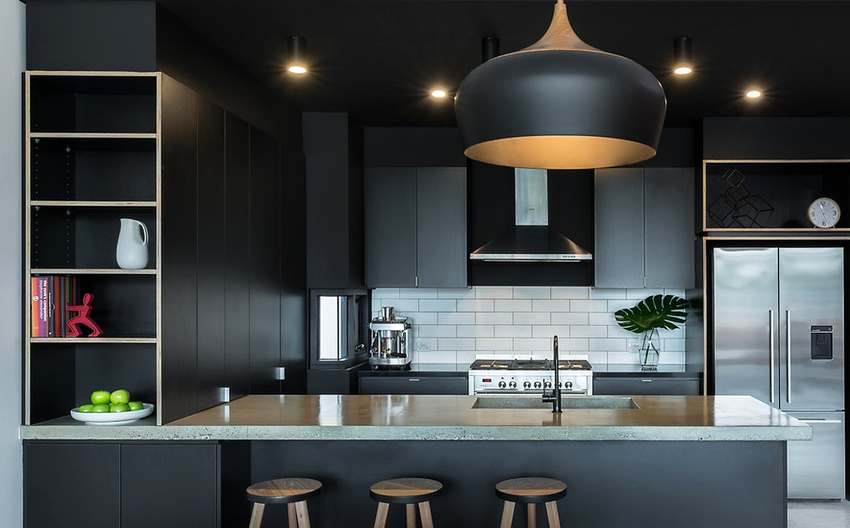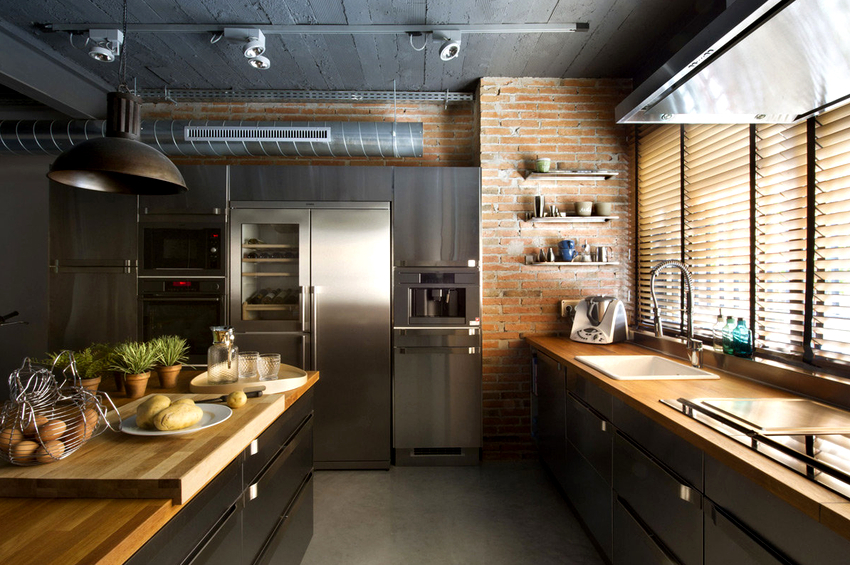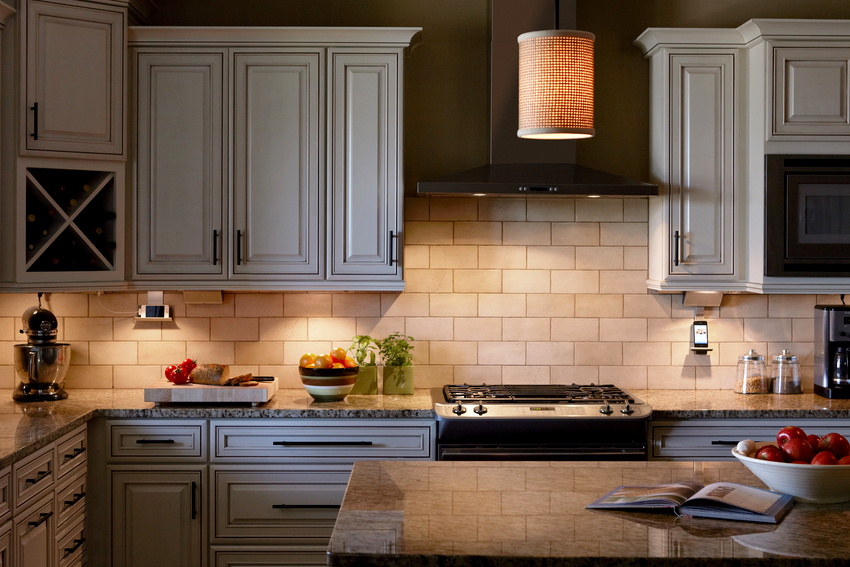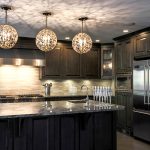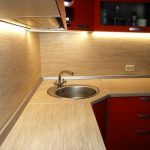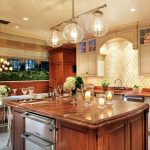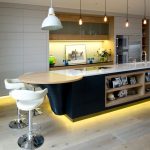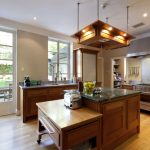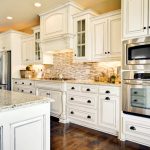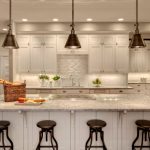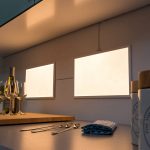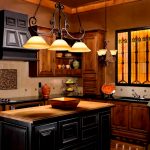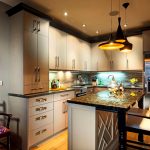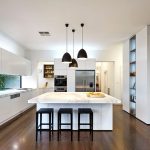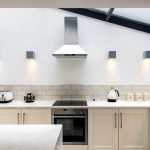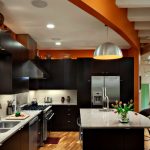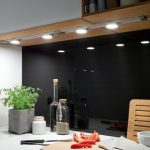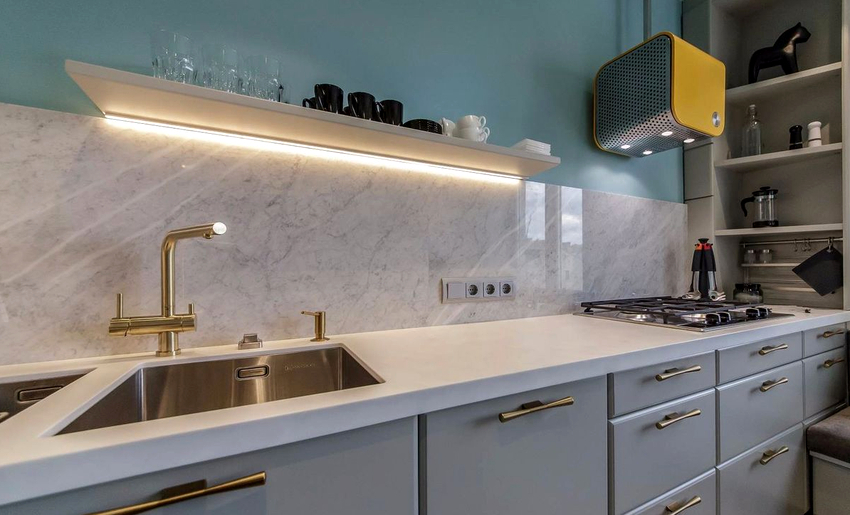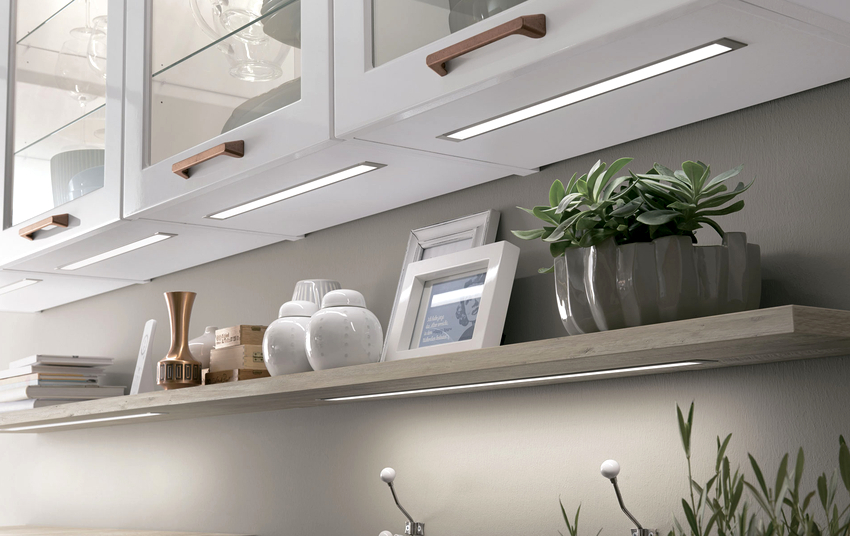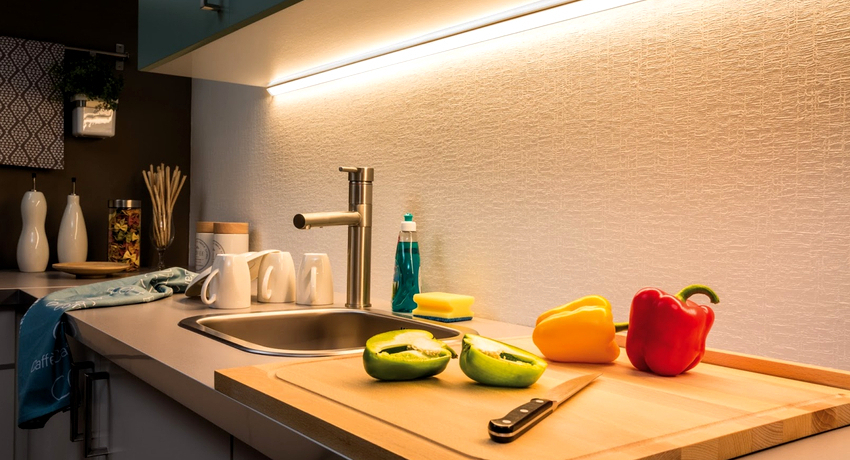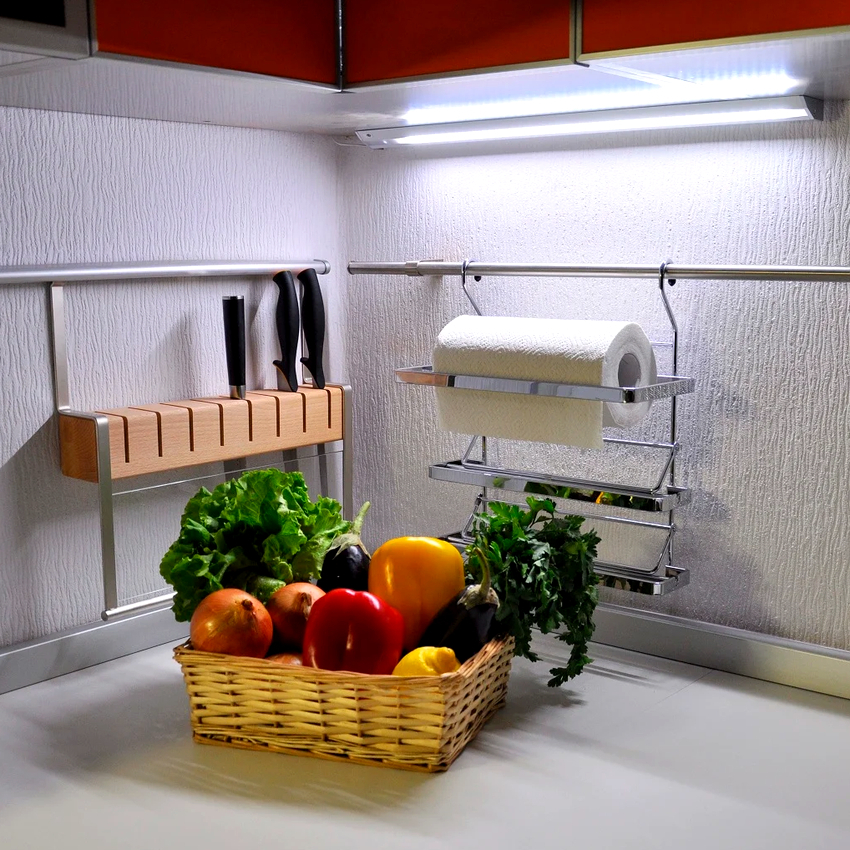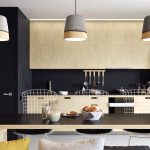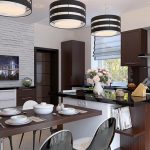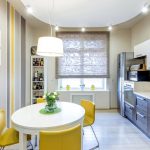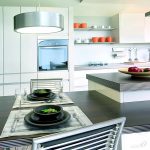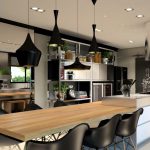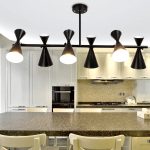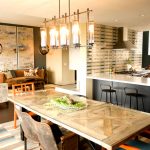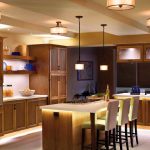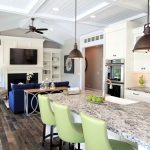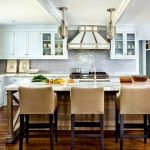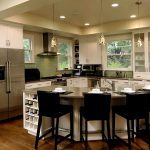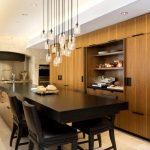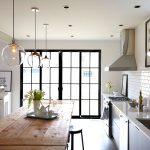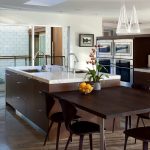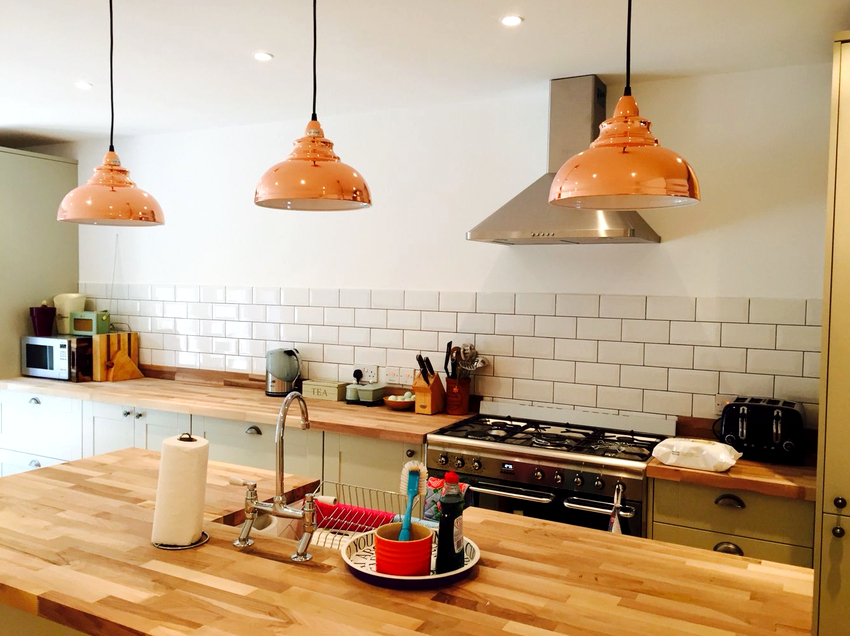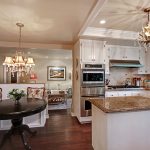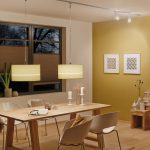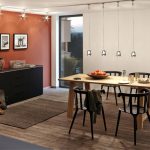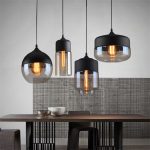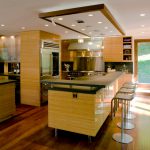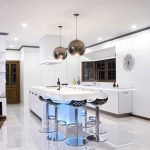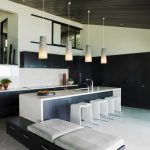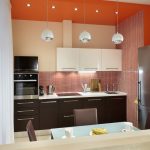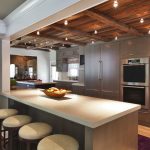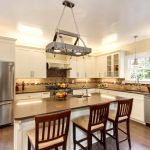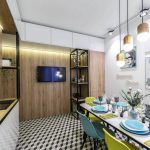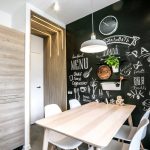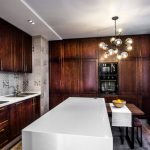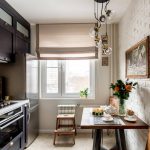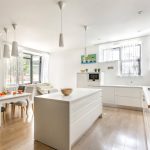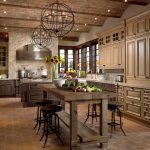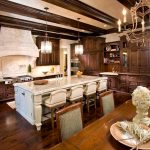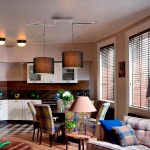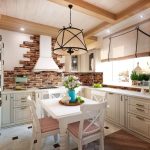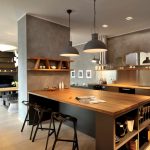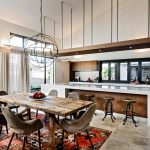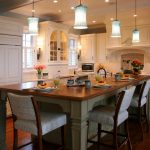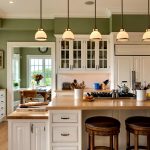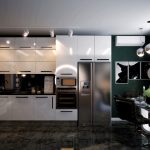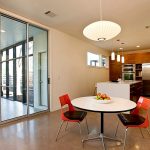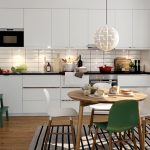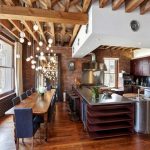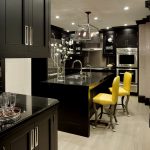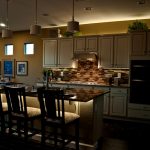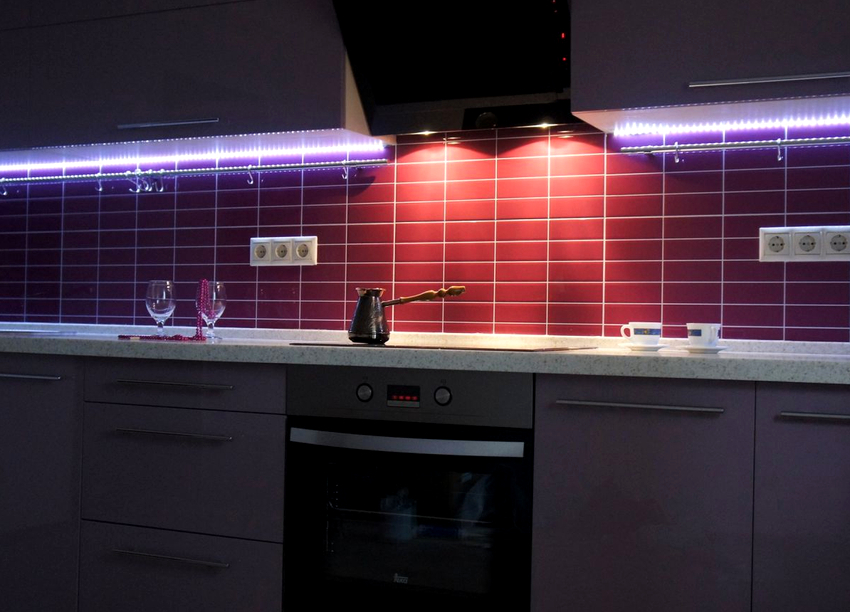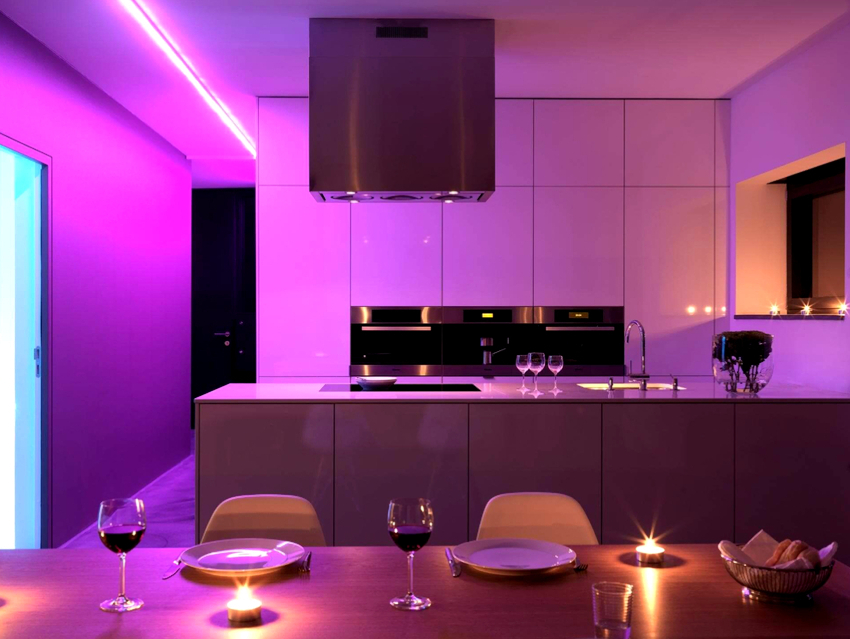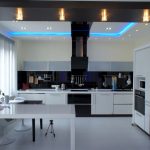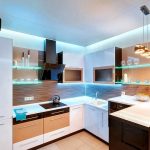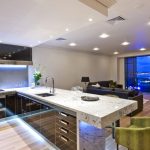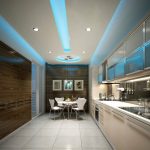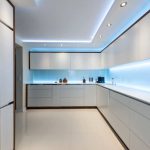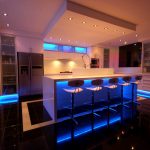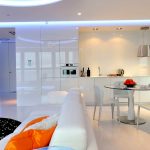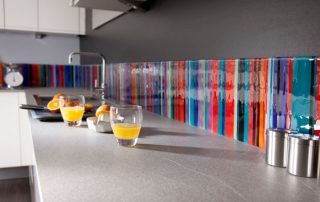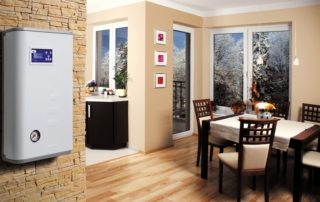The kitchen combines several functional areas. To ensure convenient and comfortable operation of each of them, it is important to choose the right finish, functional furniture, to achieve harmony of color and decor. In order for the interior to play in a single harmonious concept, the lighting in the kitchen should be properly organized. It must comply with certain rules, which can be found in this article.
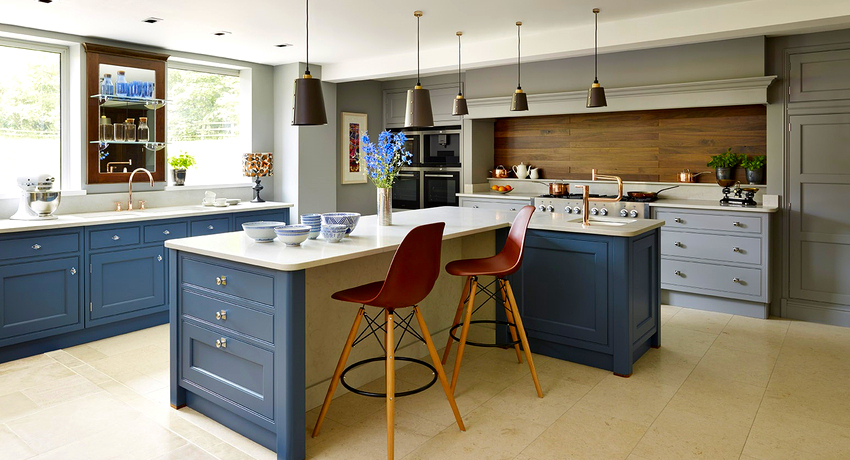
In order for the interior to play in a single harmonious concept, lighting in the kitchen should be properly organized
Content [Hide]
- 1 Basic principles of organizing kitchen lighting
- 2 How to make lighting in the kitchen to correct its shape
- 3 How to properly organize lighting in a kitchen studio
- 4 Varieties of lamps for the kitchen: characteristics of each option
- 5 Kitchen lighting color options
- 6 Luminaires for lighting in the kitchen with a stretch ceiling or other coating
- 7 General lighting when using ceiling lights in the kitchen
- 8 Lighting for the kitchen in the work area: placement rules
- 9 Spotlights in the kitchen: features of the work area lighting option
- 10 Lighting options in the kitchen dining area
- 11 Decorative lighting options for the kitchen space
Basic principles of organizing kitchen lighting
What should be in the kitchen for a comfortable stay indoors in the evening? First of all, lighting must be properly organized. A competent approach involves the use of several options for lighting fixtures that create multi-level lighting. Thus, it will be possible to illuminate each functional area.
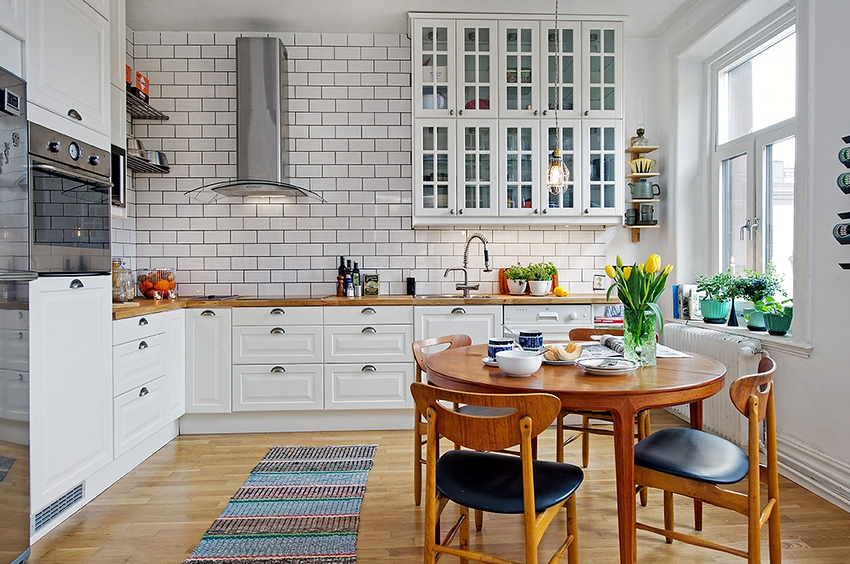
When choosing the number of lighting fixtures, you need to pay attention to the decoration of the room
The main light in the kitchen is provided by a central chandelier in a single copy, which is typical for a small kitchen, or several products of the same type. The work area is illuminated using bright light sources, which should be located above the table top.
A chandelier, wall sconces and ceiling lamps can be used to illuminate the dining table. An important role in the kitchen is played by decorative lighting, which is mounted inside cabinets, along the ceiling, plinth, bottom and top of the kitchen unit.
There are several requirements for proper lighting in the kitchen. It is necessary that the light in the room is evenly distributed over the entire area, excluding the occurrence of darkened areas. The shade should not fall on the work and dining areas. The lamps are positioned so that they do not shine in the eyes and do not create glare.
It is required to correctly select the number and wattage of lamps that provide moderate brightness. It should be remembered that the more lighting fixtures are installed, the less their power should be. The light should not dazzle or be dim. All lighting fixtures are selected in the same style.
When choosing the number of lighting fixtures, you need to pay attention to the decoration of the room. Light tones are able to reflect light by 80%, while dark tones can only reflect 12%.
Important! The lighting fixture must be located at least 60 cm from the socket.
For convenient operation and rational use of electricity, it is important to provide a separate light switch for each functional area. For the kitchen, you should give preference to lamps that are simple in shape and minimalist in design, which are easy to clean from dust, soot and grease.
How to make lighting in the kitchen to correct its shape
With the help of a certain kitchen lighting option, you can visually adjust the shape and size of the room. By placing several light sources in the longitudinal direction of the room, you can visually lengthen it. The transverse placement of the lighting fixtures is aimed at giving the kitchen a square shape. The same effect can be achieved by illuminating the far wall in a narrow room, which makes it visually more spacious. Both options can be seen in the photo of lighting in the kitchen.
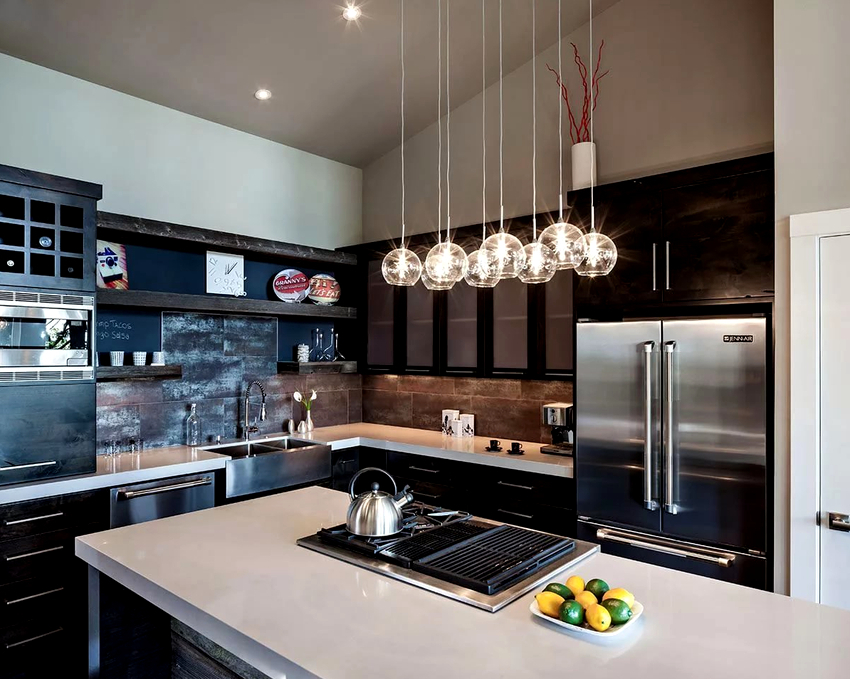
With the help of a certain kitchen lighting option, you can visually adjust the shape and size of the room
Ceiling lamps, located on the surface in several even rows, are able to "raise" the ceiling of the room, adding weightlessness to the interior.
You can erase the horizontal and vertical edges of the kitchen by installing lighting fixtures with reflectors. The opposite effect, reducing the height of the ceiling, aimed at making the interior expressive, can be obtained with the help of lamps on the ceiling, the rays from which are directed to the walls of the room. It is possible to emphasize the configuration of the room by visually expanding it by organizing lighting around the perimeter of the ceiling. Photos of kitchen lighting clearly demonstrate different design approaches to adjusting the dimensions of the room.
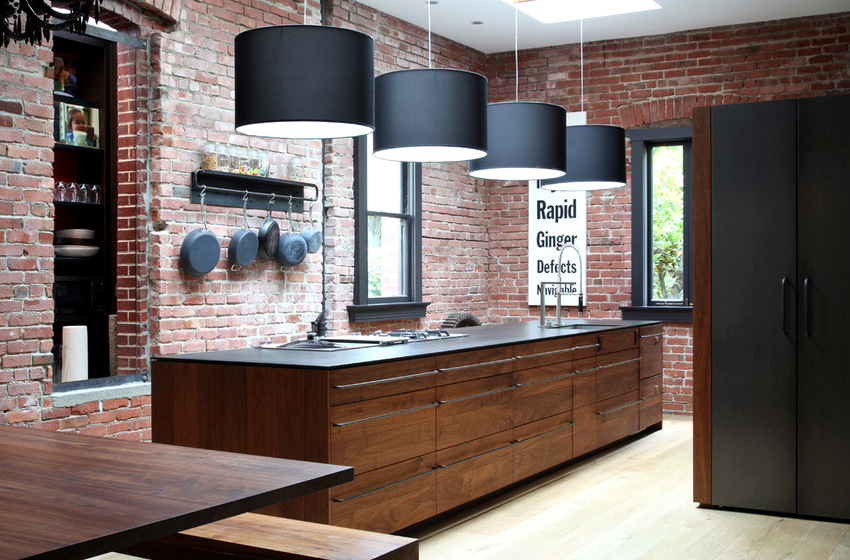
By placing several light sources in the longitudinal direction of the room, you can visually lengthen it
Useful advice! The maximum effect for the visual increase in the size of the kitchen can be achieved with the simultaneous use of bright lighting, reflective finishes and glossy furniture fronts.
How to properly organize lighting in a kitchen studio
There are usually 2-3 functional zones in a studio kitchen. For each of them, it is necessary to organize individual lighting. To create a harmonious design of interconnected rooms, one should not forget about maintaining a single stylistic concept.
Lighting in a small studio kitchen does not involve the use of a large number of powerful lamps, which will create too bright light. Volumetric lighting fixtures are also inappropriate. In this case, the most correct solution would be to use built-in LED lamps, small wall sconces and spotlights. All light sources must provide diffused light, due to which the effect of expanding the space will be created.
A convenient option for a combined room is LED consoles. Due to the possible adjustment of the position of the devices, which is carried out by means of a rotary mechanism, they can play the role of both the main and local light sources, scattering the luminous flux to varying degrees.
Important! Different lighting is performed without fail in the absence of a clear visible border between the zones in the form of a screen, piece of furniture, podium, color and finishing material.
In the kitchen-living room, it is important to organize lighting of different intensities.This is due to the fact that in this room there is a rest corner, a place for receiving guests and a work area. In the kitchen and dining space, a bright base light is set up for each place separately. It can be adjusted according to the light level.
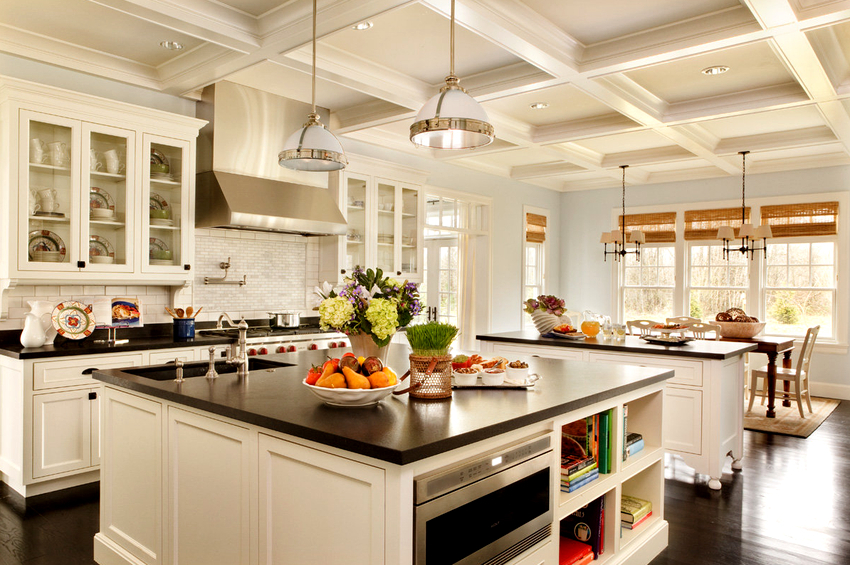
Different lighting is performed without fail in the absence of a clear visible border between the zones in the form of a screen
Above the dining area, it is advisable to place a pendant lamp in the kitchen or arrange floating lighting using a bus system. As an additional light source, a tall floor lampthat can be placed on the side of the table.
Related article:
Chandelier in the kitchen: a competent approach to choosing a lighting fixture
Color palette, stylistic design and material for making lighting fixtures. Installation methods.
To illuminate the seating area, it is best to use additional lighting fixtures that provide soft, subdued light. It can be wall sconces, floor floor lamps or lamps on clothespins.
Varieties of lamps for the kitchen: characteristics of each option
The lamps installed in the kitchen have a direct impact on the overall perception of the room's design. Incorrectly selected products can distort color, which has a negative effect on the human condition, fatiguing him and reducing his performance.
Currently, you can buy incandescent, halogen, fluorescent and LED bulbs in stores. The first option is significantly outdated. It needs a lot of electricity, heats up quickly and has a short service life. Incandescent lamps are suitable for traditional lighting fixtures. The indisputable advantages include the fact that the products provide soft warm light and have a low cost.
Halogen lamps light up and go out smoothly. They are characterized by high lighting levels, low energy consumption and durability. They are able to reproduce a luminous flux as close as possible to the natural spectrum, which helps to reduce fatigue of the human organs of vision. However, such lamps quickly heat up, so it is impractical to use them for stretch ceilings and lighting fixtures made of plastic.
Fluorescent light sources create a soft, pleasant, warm white glow and have a long service life. However, such products are unsafe due to their ability to release mercury vapor into the atmosphere.
The LED backlight is characterized by environmental friendliness, practicality and durability. They do not heat up, are characterized by a high rate of energy efficiency, provide a sufficient level of light and an even distribution.
Kitchen lighting color options
Light bulbs can create a different shade of light flux, which affects the person and the external perception of the design of the room in different ways. Warm tones promote relaxation, while cold tones have a tonic effect. There are four lamp color options: rich yellow, mild yellow or warm white, neutral white, and cool white with a blue tint.
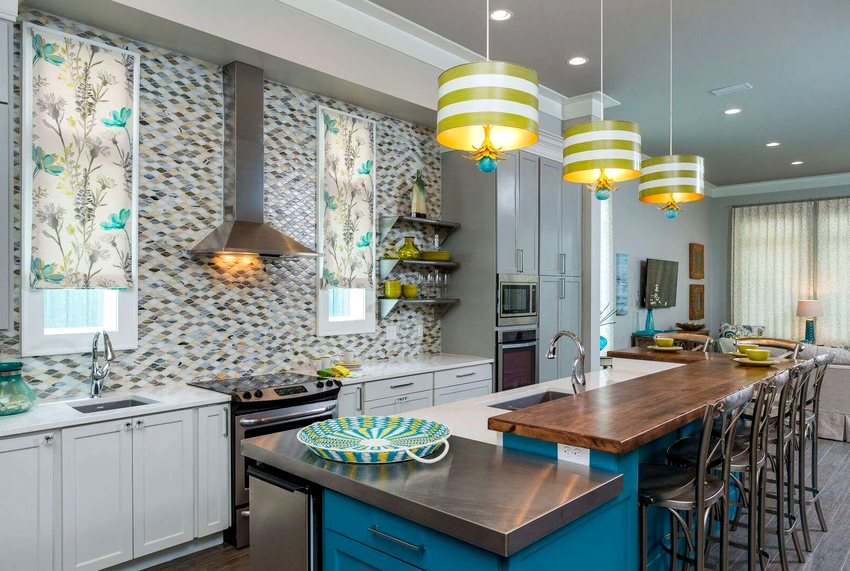
There are four color options for the lamps: yellow, mild yellow or warm white, neutral white and cool white with a blue tint
The first option reduces performance, quickly gets tired and causes apathy. A moderate warm yellow color is a natural tone that creates a calm, welcoming environment. This kitchen lighting option can be used in the dining area for daily family meals and for the work surface.
On the other hand, neutral white light promotes physical activity, improves tone and energizes. It is best suited for a workplace or fast food area. Cold white with a blue tint quickly tires. It is recommended to use it as a decorative lighting in the kitchen to create light boundaries for the zoning of the territory in the case of combining rooms.
When choosing the shade of the luminous flux, it is necessary to focus on the design features of the room. If the kitchen is designed in soft warm colors, use warm options for lighting. Cold shades of kitchen lighting will distort and blur furnishings, especially if they are designed in gray, blue, purple, yellow, sand or green tones. The neutral white color leaves all interior elements unchanged.
Luminaires for lighting in the kitchen with a stretch ceiling or other coating
The choice of luminaire is determined based on personal preference, the style of the room, the budget and the type of ceiling covering. For a traditional painted or whitewashed ceiling, ceiling or pendant chandeliers or lamps are used. For a plasterboard or slatted structure, which is mounted at a certain distance from the base, any type of lighting fixture is suitable, from conventional products to built-in lighting systems. Different options are shown in the photo of lamps for the kitchen.
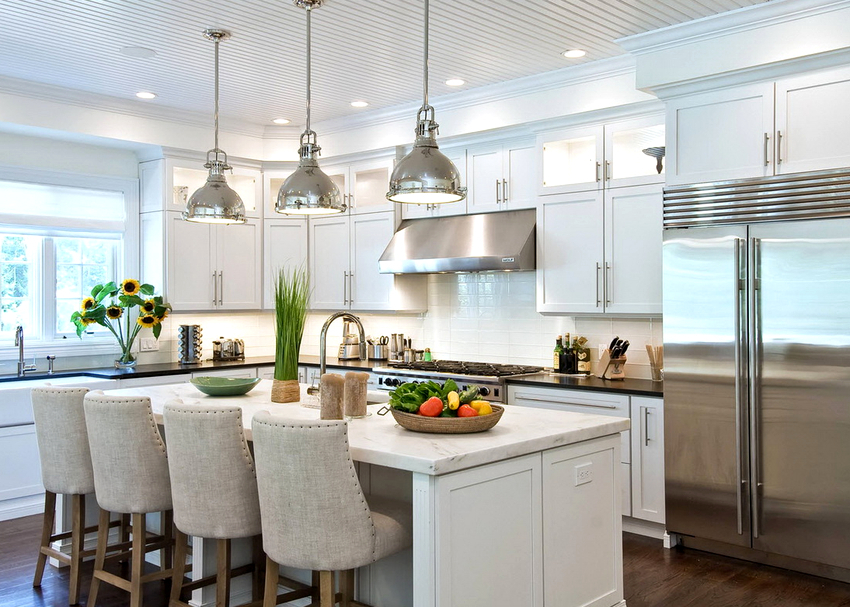
The choice of the lamp is made based on personal preferences, the style of the room, the budget and the type of ceiling covering
A special approach to the choice of lighting fixtures requires a stretch ceiling. Such a coating is represented by a PVC film or a special fabric that is stretched over the profile. Stretch ceilings are particularly sensitive to high temperatures, which can cause deformation or damage to the integrity of the structure.
Lighting in a kitchen with a stretch ceiling can be organized by using any version of a pendant chandelier, in which the shades are directed downward or to the sides. Spotlights and spots of any configuration look good. They can overlap or crash into the harness. As for the overhead lamps for the kitchen, in this case it is appropriate to install appliances with reflectors.
Important! For a stretch ceiling, models of spotlights that are attached by means of special brackets are suitable, and models with two clips for such a surface are unacceptable.
How to make lighting on the ceiling with a tension surface in the kitchen? The preferred option in this case is the use of LED models, characterized by a low level of heating. Such lighting can be located behind the covering, which will visually raise the ceiling. With the help of the LED strip, you can create glowing patterns on the surface or emphasize the originality of the photo printing pattern.

In the case of creating a multi-level structure, lighting can be built into the shelf of the lower tier
Another option involves the organization of backlighting located along the perimeter of the kitchen. This creates an incredible floating ceiling effect. In the case of creating a multi-level structure, lighting can be built into the shelf of the lower tier, decorating the ceiling. This option allows you to zone the room.
General lighting when using ceiling lights in the kitchen
The overhead light is responsible for lighting the entire interior space of the room. It should be soft, uniform and diffused. Central lighting in the kitchen can be presented in several options. You can use a chandelier, pendant lamp, built-in spot, surface-mounted, bus light sources or LED lighting.
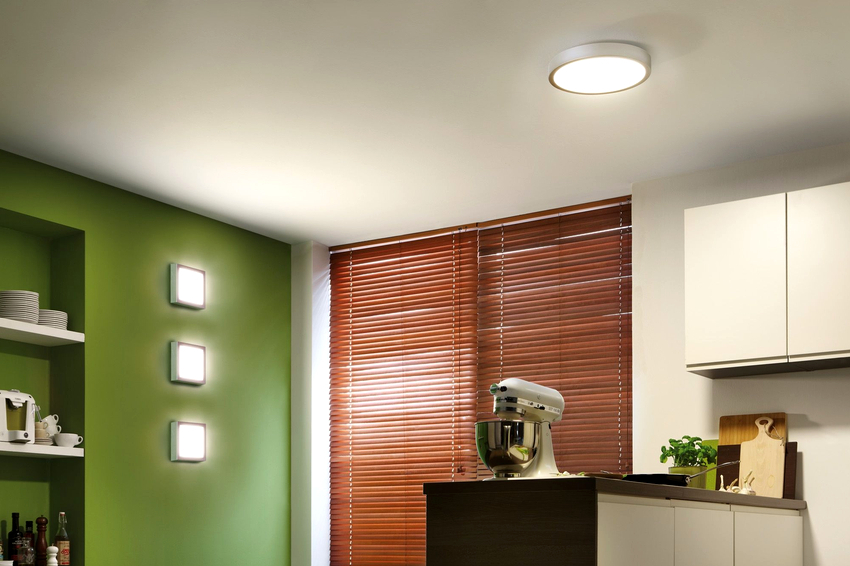
For central lighting, you can use a chandelier, pendant lamp, built-in spot, surface-mounted, bus light sources or LED lighting.
The traditional solution is to install the chandelier in the center of the kitchen ceiling. This option is appropriate for small spaces. If the kitchen has a low ceiling, it is better to give preference to ceiling options. In other cases, suspended structures are often used. In the photo of the lamps in the kitchen, you can consider interesting options for lighting the room.
Ceiling lamps on rails are a good solution for the kitchen, which makes it possible to turn the appliance in any direction.
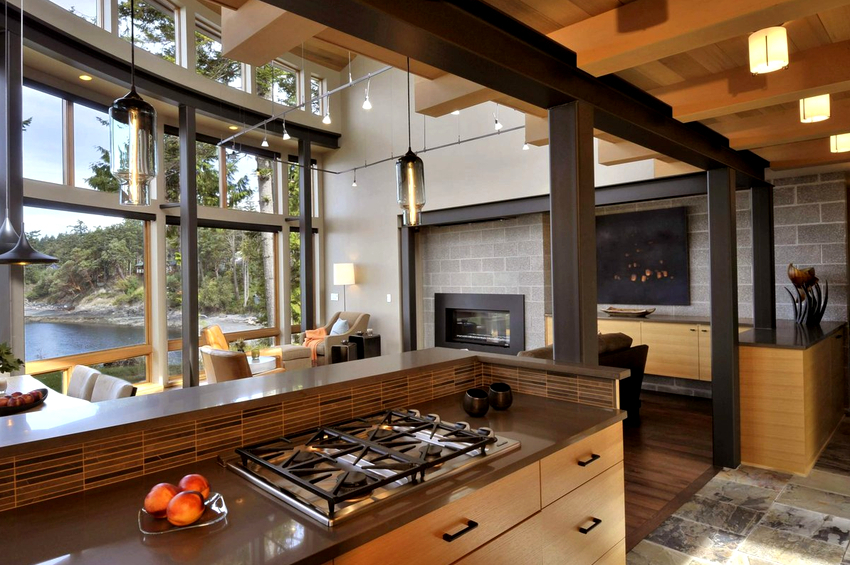
The traditional solution is to install one large chandelier in the center or several small ones in different parts of the room.
In a spacious room, general lighting can be organized by spotlights, which can be equidistant from each other along the entire ceiling or along its perimeter, creating a light ornament on the surface. This option is used for stretch or plasterboard ceilings. Spotlights in the kitchen visually raise the level of the ceiling, making the room more spacious.
Important! The distance between adjacent spotlights should be at least 40 cm, and 25 cm away from the walls.
A good effect is created by LED lamps that do not form shadows. This lighting option is able to correct the unfortunate shape of the room. When the same elements are located on one side of a narrow kitchen, the room becomes wider. To visually narrow the kitchen, LEDs are mounted along the middle ceiling line. For maximum convenience, you can purchase LED lamps with a built-in motion sensor, thanks to which the light will turn on if someone enters the room and turn off when someone is absent from the kitchen.
Useful advice! To visually expand the space, it is recommended to illuminate the upper corners of the room.
You can create attractive visual effects by combining different lighting options in your kitchen. In this case, all lighting fixtures should be selected in the same style in order to harmoniously fit into the overall concept of the interior of the room.
Lighting for the kitchen in the work area: placement rules
The workspace in the kitchen, which is represented by a worktop with a hob and a sink, must be sufficiently well lit to ensure convenience and comfort during cooking. Luminaires for the kitchen above the work surface are most often located under the bottom of the wall cabinets of the kitchen set. Lighting fixtures can be placed on the border of the hanging furniture and the wall, or closer to the outside of the elements. The second option is more preferable, since it provides maximum illumination of the working area.
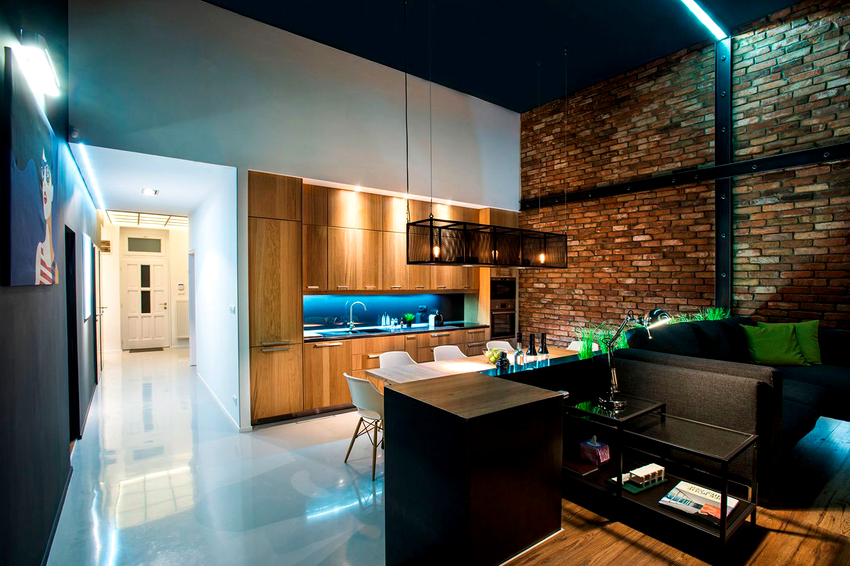
The work space in the kitchen, which is represented by a worktop with a hob and a sink, must be sufficiently well lit
Important! Illumination of the workplace should be organized in such a way as to achieve the maximum level of illumination of the surface of the tabletop, without glaring the eyes and without forming shadow areas.
If the hanging cabinets are equipped with a cornice, then this is the most suitable place for the location of spotlights. Kitchen furniture lamps in the form of LED lighting can be installed inside cabinets with transparent doors. It will work when the doors are opened.
There are other options for placing the illumination of the workplace. The light source can be located on the ceiling.In this case, the light will hit the back of the person standing at the countertop, creating a shadow in the workplace. This option is advisable to use in the absence of wall cabinets. If the lamps are located along the line of the kitchen unit on the ceiling, it will be possible to provide illumination to a narrow part of the countertop, while the rest will be in the shade.
Useful advice! A glass apron with built-in LED illumination looks original and stylish in the kitchen interior, at the same time providing illumination of the working area and playing the role of a decorative element of the interior.
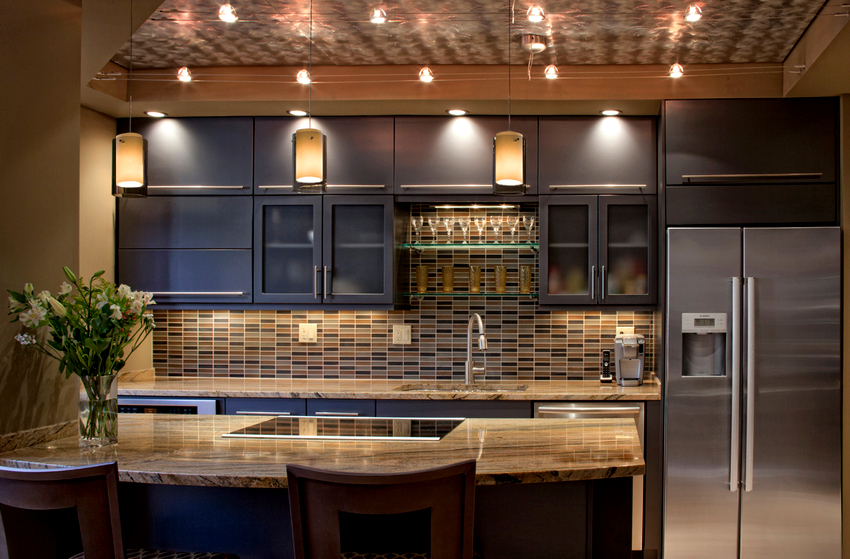
If the lamps are located along the line of the kitchen set on the ceiling, it will be possible to provide illumination of a narrow part of the countertop
However, the organization of lighting for the working area in the kitchen at the bottom of the wall cabinets creates two problems: an unsightly appearance and discomfort from bright light for those sitting at the table. Both issues can be solved with a decorative strip that will cover the lamp and limit the light, making the lighting softer.
The location of the bar, its height, and external configuration are selected based on the type of the selected luminaire. The ideal option is such a solution when the light falls exclusively on the countertop, and not on other elements of the room.
The bar can serve as a shelf for various kitchen items. The best way is also to organize a double bottom in cabinets, where it is easy to hide the backlight. Frosted glass can be installed here, providing soft diffused light.
Spotlights in the kitchen: features of the work area lighting option
There are several options for organizing lighting above the work surface in the kitchen: spotlights, fluorescent lamps and LED strips. Each of them has its own distinctive advantages and disadvantages.
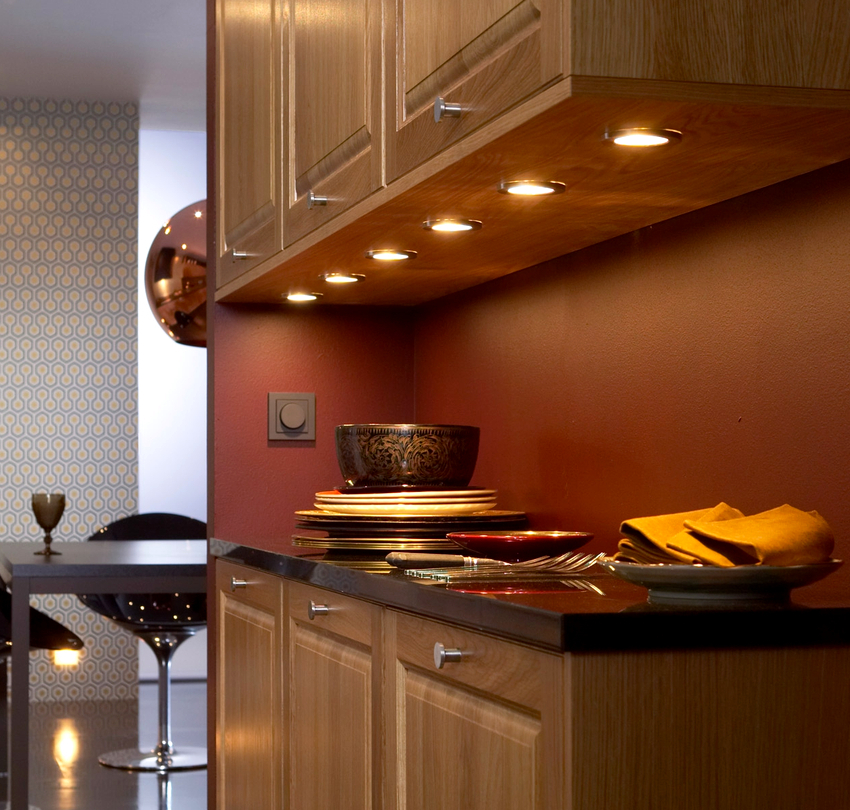
There are several options for organizing lighting above the work surface in the kitchen: spotlights, fluorescent lamps and LED strips
The most rational and effective option is a point light. It can be located in the lower part of the hanging furniture or be fixed on a specially attached false bottom. A feature of this type of lighting is the ability to illuminate individual sections of the working area.
Another option is to use surface-mounted kitchen fixtures, which should be spaced 30-45 cm apart. The installation of light beams is considered a new-fashioned solution. Lighting devices are distinguished by a simple design, a high level of illumination, the ability to control the brightness and degree of illumination of a certain area. They are attached to the niche of the furniture set. The advantage of the products is considered to be a long service life, and the main disadvantage is the high cost of the light beams.
Spot lighting in the kitchen for the work area provides different intensities of illumination of individual areas. With frequent luminaires, this contrast can be minimized. This backlight looks nice and modern. However, spotlights have a certain height, therefore, for their location, they equip a second bottom for wall cabinets.
Linear lighting in the kitchen under the cabinets: popular options
Linear lighting in the kitchen under the cabinets is organized with the help of lamps, which are located next to each other at a short distance (a couple of centimeters). There are two types of such backlighting: fluorescent lamps and LED strip.
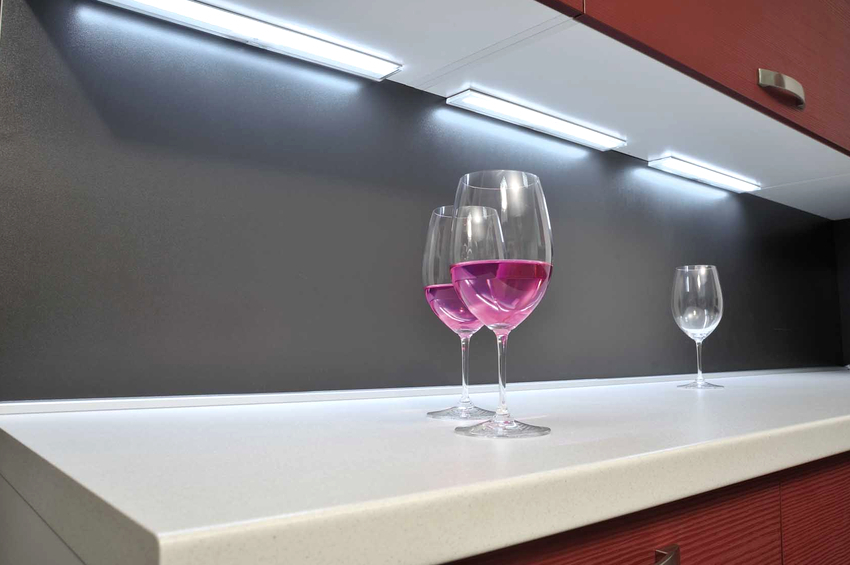
Linear lighting in the kitchen under the cabinets is organized using lamps that are located next to each other at a short distance
Fluorescent lamps are a traditional illumination option and have an acceptable cost price.They are fixed to the bottom of the wall cabinets of the kitchen unit by means of screws with their own hands. Kitchen lamps of this type provide uniform, intense lighting that spreads to all sides of the room, which can cause some discomfort for others. To minimize this disadvantage, lighting devices should be equipped with a special border that performs a protective and decorative function.
For the kitchen, choose lamps with a G13 base in lengths of 60, 90, 120 or 150 cm. Models can have a traditional or original design.
Among the advantages of fluorescent backlighting are energy efficiency of products, durability and the ability to emit various light shades. Such a backlight is connected directly to a 220 V network. The main disadvantage is the content of mercury in the product, which requires careful operation and special disposal conditions. In addition, fluorescent lamps create pulsation of light, which has a negative effect on human eyes.
Lighting in the kitchen with LED strips and lamps
A popular and effective solution is the use of LED lighting in the kitchen. This option is characterized by practicality, which is especially important for rooms with high levels of humidity and temperature fluctuations, durability, low energy consumption, resistance to voltage surges in the network and affordable cost.
LED strips can have different levels of brightness, creating different options for the saturation of the white luminous flux. You can adjust the power using the remote control or touch panel. And you can also choose LED strips in red, blue, yellow or green, creating a design accent in the interior of the room.
The tapes are easily mounted to the wall, ceiling or the bottom of hinged kitchen furniture using staples, glue or tape with your own hands. LED lighting in the kitchen can be organized using a special transparent removable panel with an internal shelf for fixing the tape. Among the existing options, you should choose models with a high level of protection - IP44 and higher. Products must be coated with varnish or other protective compound. For the kitchen, options with a crystal size of 50x50 and 50x75 are suitable, which can be arranged in two rows.
Important! To organize home lighting, you should not purchase LED strips, sealed into a tube, which quickly overheat, fade and burn out.
In addition to LED strips, there are models of lamps for the kitchen (the photo is a clear confirmation of this), represented by tubes. They are mounted on clips with magnetic fixing, which are mounted to furniture. When connecting LED strips and lamps to the mains, special adapters should be provided that provide the required voltage.
Lighting options in the kitchen dining area
The dining area can be illuminated with a chandelier, ceiling lights or wall sconces. It is advisable to arrange the latter option when placing the table near the wall. For a good level of lighting, it is better to give preference to models in which the plafond to the kitchen is at some distance from the wall and provides a direction of the light flux from top to bottom.
Wall sconces should be located 60-80 cm from the table surface. This option has its drawbacks.Wall sconces strongly diffuse light, leaving some parts of the tabletop in the shade, which provides insufficient illumination of the table.
The most popular solution is to use a large pendant or ceiling chandelier above the center of the table. It is equipped with a beautiful translucent glass shade or transparent plastic shade. The design of the chandelier is selected based on the condition that the plafond should be at least 1.2 m from the table surface. The best options for lamps above the table are models in the form of a ball, cone, rectangle or semicircle.
The retro style Edison lamp will look original in the kitchen interior, the size and shape of which can be varied. It can be used in a single copy or in a composition of several pieces, which will be a fashionable nostalgic interior decoration. The lighting fixture can be installed without a lampshade on a cord. A new-fashioned solution is models that resemble a spider in appearance, where several lamps on long cords are used.
In the case of using the pendant lighting option in the kitchen above the table, it is better to give preference to models that have adjustable suspension length. If the lamp is raised high, the dining area can be brightly and solemnly lit. Lowering the chandelier creates a more cozy and homely atmosphere.
A good solution is to use several small ceiling lights, which should be located at the same distance from each other along the central axis of the table, which is best suited for lighting a 9 sq. m. dining table.
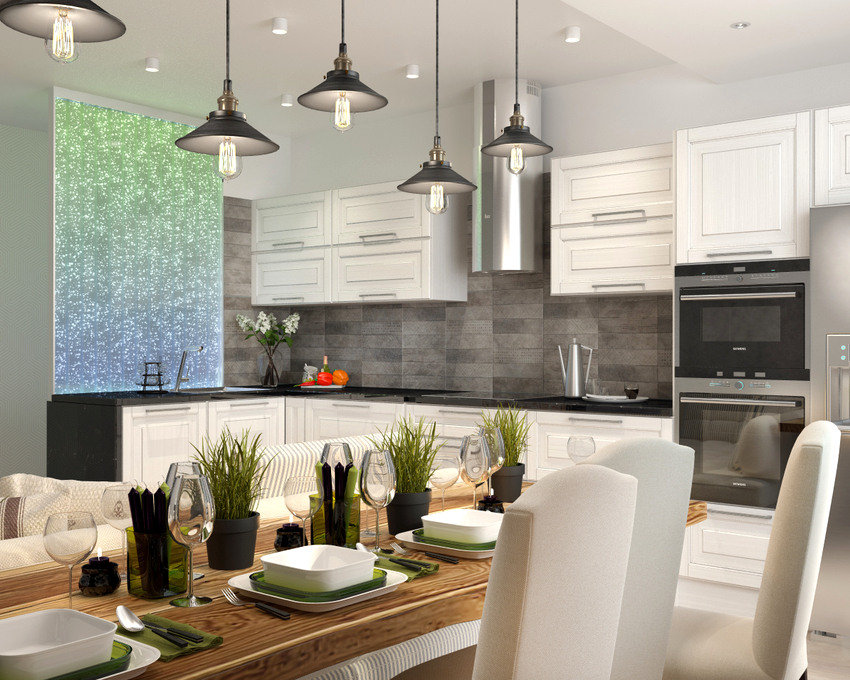
In the case of using a pendant lighting option in the kitchen above the table, it is better to give preference to models that have adjustable suspension length
Useful advice! It is better to install one lighting device above a round or square table, and 2-3 lamps should be preferred to illuminate an oval or rectangular table or bar counter.
For a spacious kitchen, which is combined with a living room, a good option would be to organize built-in spot lighting, which will not only illuminate the dining area, but also become an element of dividing the space. A bus system with several lamps with a swivel structure above the dining area looks interesting in a modern interior. This is the preferred option for folding tables, as the swivel lighting systems allow you to adjust the direction of the light flow.
Decorative lighting options for the kitchen space
As decorative additional lighting in the kitchen, they use LED strip or lamps, neon pipes of different colors, fluorescent lamps. The backlight can be placed in different parts of the room, creating an original and unique room design. It can be located between the ceiling and wall cabinets of the kitchen set, on the basement of the furniture, on the refrigerator, in niches, above the cornice or working area.
By placing the LED strip under the countertop, you can create a beautiful night illumination of the kitchen furniture set, as if floating in the air. The illumination of the front of the kitchen island or peninsula looks impressive and stylish.
The best element of a room for decoration is a suspended multi-level ceiling. Light sources can be placed in curly niches, at the joints of individual structural elements or along the perimeter of the ceiling. For lighting the ceiling in the kitchen in the case of a multi-level structure, illuminated spotlights are a suitable solution.
Decorative lighting fixtures can also be on the floor - in a recess or flush with the surface. For the second option, it is better to choose point products with durable glass that are capable of withstanding the load from ceramic tiles with built-in diodes.
For decorative wall decoration, you can use lamps with a reflective effect, which direct the flow of light towards the ceiling, or classic sconces of the original design. Photos of a backlit kitchen clearly show all the advantages of such lighting.
As decorative lighting, which is also an additional light source, you can use mobile lighting fixtures on clothespins. They can be easily fixed anywhere or transferred to a new one if necessary.
A neon sign can be placed on the wall near the dining table, which will give the room an original appearance. With its help, you can emphasize the romance of the atmosphere during dinner or revive it during gatherings with friends.
Modern light sources are able to create the most comfortable and convenient environment in the kitchen. Photos of lighting in the interior of the room clearly demonstrate how important it is for each logical zone to organize separate lighting, which is selected taking into account the characteristics of the room, its stylistic design and personal preferences. All lighting fixtures must be in harmony with each other, forming a general interior concept.
